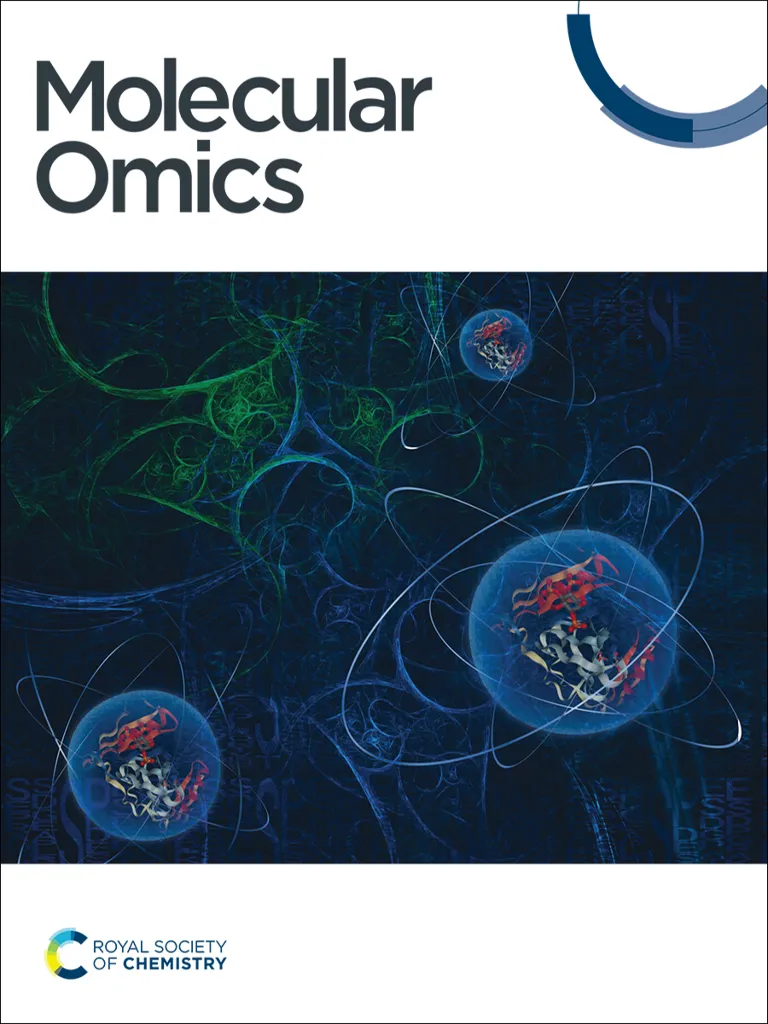Molecular Omics
A journal for leading research in multi-omics and single-omics technologies.
Chair: Robert Moritz
Open Access: Hybrid

A new home for Molecular Omics: Molecular Omics will be published by Oxford University Press from January 2026.
Please visit the new journal website for more information
Molecular Omics publishes high-quality research in the -omics sciences. We welcome scientific research based on the application of any -omics technology and we encourage multi-omics approaches to solving important chemical or biological problems. This includes combining different types of omics platforms encompassing genomics, transcriptomics, proteomics, metabolomics and other specialized areas such as glycomics and lipidomics, as well as innovative bioinformatics approaches.
ISSN: 2515-4184
Indexed in: Web of Science, Scopus, MEDLINE
Journal Impact factor
2.4 (2024)
First decision time (all)
14 days
First decision time (peer reviewed)
65 days
Scope
Molecular Omics publishes high-quality research from across the -omics sciences that provide significant new insight into important chemical or biological problems.
Molecular Omics articles report research that significantly increases understanding or demonstrates clear functional benefits, supported by experimental validation or a novel data analytic approach.
Topics include, but are not limited to:
- omics studies to gain mechanistic insight into biological processes – for example, determining the mode of action of a drug or the basis of a particular phenotype, such as drought tolerance
- omics studies for clinical applications with experimental validation, such as finding biomarkers for diagnostics or potential new drug targets
- omics studies looking at the sub-cellular make-up of cells – for example, the subcellular localisation of certain proteins or post-translational modifications or new imaging techniques
- studies presenting new methods and tools to support omics studies, including new spectroscopic/chromatographic techniques, chip-based/array technologies and new classification/data analysis techniques. New methods should be proven and demonstrate an advance in the field.
- shorter research articles describing new methodologies, techniques or technologies, or noteworthy advancements in methodology are welcome.
The following are not within the scope of Molecular Omics:
- Research based on reanalysis of public datasets without experimental validation and significant omics datasets
- Papers without significant biological justification or interpretation
- Research that is only of interest to the specialist in the area
- Papers reporting new results that could be routinely predicted
- Papers that do not show a significant improvement over known research
Readership
Researchers from industry and academia interested in molecular level research in proteomics, transcriptomics and metabolomics, genomics and other omics science.
Thus the journal will appeal to a wide variety of researchers, but particularly to the following:
- Chemical biologists
- Biological chemists
- Biochemists
- Molecular and structural biologists
- Drug discovery scientists
- Protein chemists
- Bio- and cheminformaticians
- Organic and analytical chemists
Information for authors
Want to publish in this journal? Our author guidelines explain how to prepare and submit your article and provide useful information on the review and publication process including transfers, revisions and any article processing charges (APCs) that may apply.
You can read our payments and funding information for further details about APCs, which may apply for publishing open access in this journal, as well available discounts and waivers.
You may be able to publish open access in this journal, with no APC to pay, if your institution has an open access agreement with us. You can use our journal finder tool to check for agreements between us and your institution.
Meet the team




Subhra Chakraborty
Editorial board member
National Institute of Plant Genome Research (NIPGR





Chris Bakal
Institute of Cancer Research
Anne K Bendt
National University of Singapore
Tunahan Cakir
Gebze Technical University
Erin Carlson
University of Minnesota
James Edwards
Saint Louis University
Claire Eyers
University of Liverpool
Alex Georgakilas
East Carolina University
Rebekah Gundry
University of Nebraska Medical Center
Walter Kolch
System Biology Ireland
Ben Lehner
Center for Genomic Regulation
Souvik Maiti
Institute of Genomics and Integrative Biology
Andrej Shevchenko
Max Planck Institute for Molecular Cell Biology and Genetics
Silke Sperling
Max Planck Institute for Molecular Genetics
Ed Tate
Imperial College London
Ronghu Wu
Georgia Institute of Technology
Grace Thoburn
Executive Editor
Hannah Fowler
Deputy Editor
Daniel Robertshaw
Development Editor
Sarah Anthony
Editorial Manager
Nicola Burton
Publishing Editor
Tom Cozens
Publishing Editor
Katie Fernandez
Associate Editorial Manager
Ryan Kean
Publishing Editor
Roxane Owen
Publishing Editor

Sam Keltie
Publisher
Read this journal
Research article
Integration of focal adhesion morphogenesis and polarity by DOCK5 promotes YAP/TAZ-driven drug resistance in TNBC
Research article
Lipidomics reveals cell specific changes during pluripotent differentiation to neural and mesodermal lineages
Research article
Transcriptome profiling of serum exosomes by RNA-Seq reveals lipid metabolic changes as a potential biomarker for evaluation of roxadustat treatment of chronic kidney diseases
Review article
Revealing the dynamics of fungal disease with proteomics
More from this journal
Contact the journal team
We're here to help. Contact the journal team if you have any questions about publishing your paper with us.
Sign up for journal email alerts
Get table of contents alerts and notifications about calls for papers, themed issues and more.
